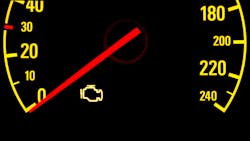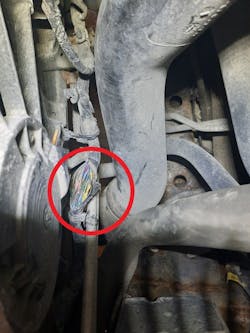Case Study: F-150 intermittent lack of throttle response
Vehicle: 2016 Ford F-150, 4WD, V6-2.7L Turbo, automatic transmission/transaxle
Mileage: 119,832
Problem: The customer’s concern was that his F-150 had developed a noticeable loss of throttle response, and the malfunction indicator light (MIL) was on.
Case Details: The technician connected a scan tool and found the following diagnostic trouble codes (DTCs):
- P2128 - Throttle/Pedal Position Sensor/Switch E Circuit High
- P2138 - Throttle/Pedal Position Sensor/Switch D/E Voltage Correlation
- U0109 - Lost Communication with Fuel Pump Control Module A
Based on the DTCs, he tried installing a “known good” accelerator pedal (at no charge), but the problem remained.
ALLDATA Tech-Assist was called for some friendly diagnostic advice. The consultant suggested inspecting connector C268 near the firewall on the driver's side. He also recommended pulling/wiggling the harness. Broken wires are a frequent problem with that particular harness.
If the connector and the harness were okay, the next thing to do was to check the accelerator pedal position sensor 2 (APP2) voltage with a scan tool while slowly pressing the pedal down. The voltage should smoothly go between zero and 5V. Next, check the voltage on the blue/white (BU/WH) APP2 signal wire at the accelerator pedal while slowly pressing it down.
The technician inspected the APP2 sensor voltage as advised. The scan tool showed 5V all the time, even with the pedal disconnected. Next, he checked the BU/WH APP2 signal wire and found it fluctuating between 9V and 10V. There had to be a short to power in the harness somewhere.
He inspected the entire harness and found six wires melted together just next to the radiator fan motor. There were no other signs of damage to the harness.
Confirmed Repair: The technician repaired the melted wires, cleared the DTCs, then completed a factory recommended drive cycle. The MIL did not come back on, and normal throttle response was restored. Problem solved!
Reprinted with permission from ALLDATA.
About the Author

Richard Diegle
Senior Automotive Editor for ALLDATA
Rich Diegle has been in the automotive industry since 1978. After graduating from a local community college, he began working at a Nissan dealership as a used car technician. Since then, he’s worked as a Nissan and ASE master automotive technician, shop owner, marketing copywriter, automotive editor, public relations manager, instructor, ALLDATA Tech-Assist team manager, and a senior automotive editor.

